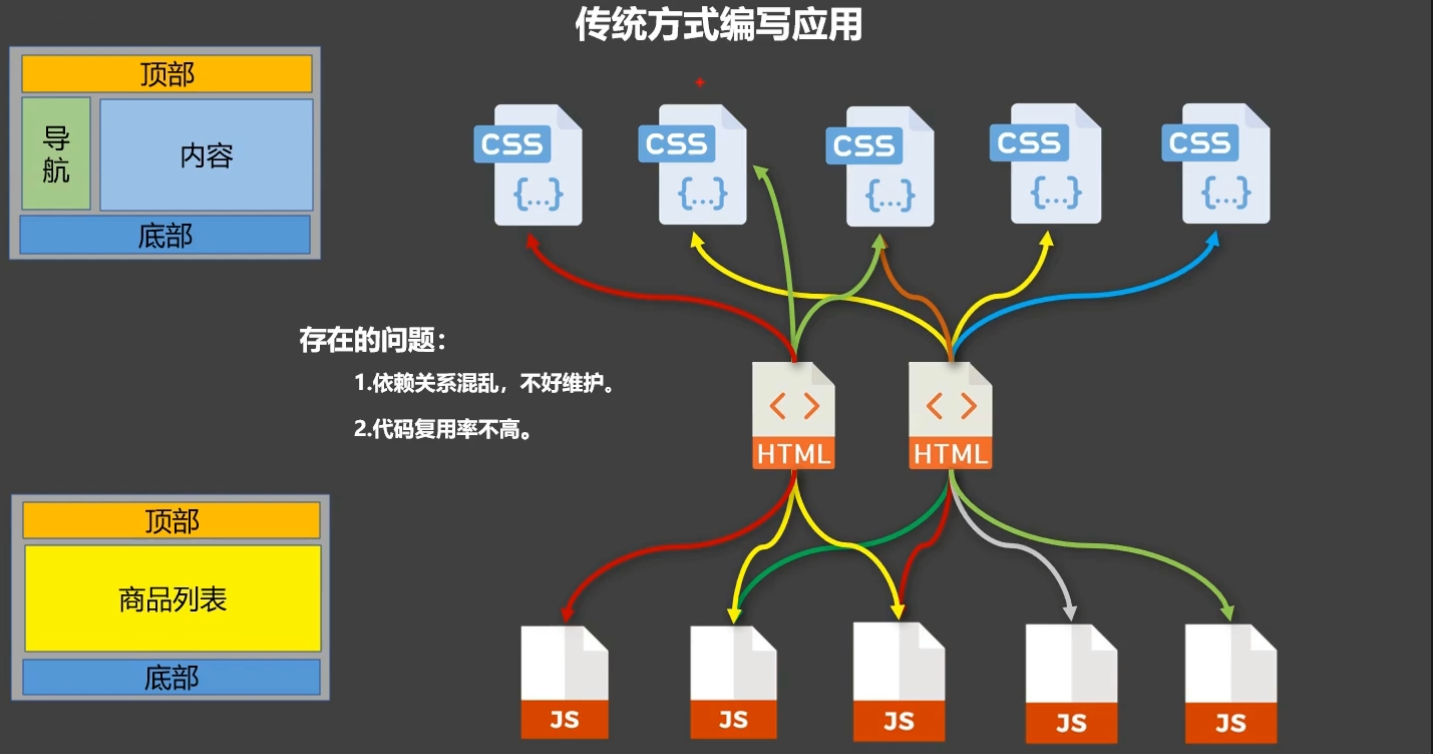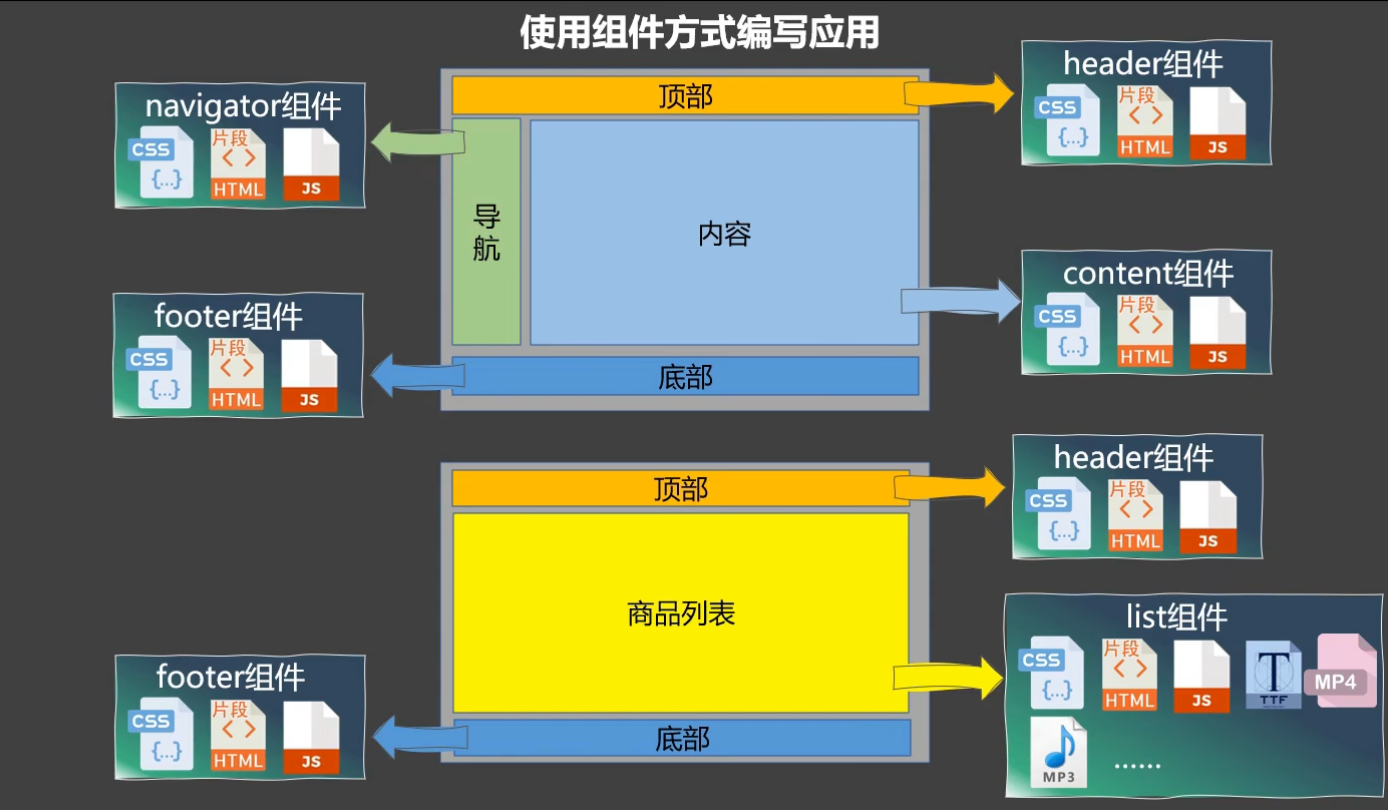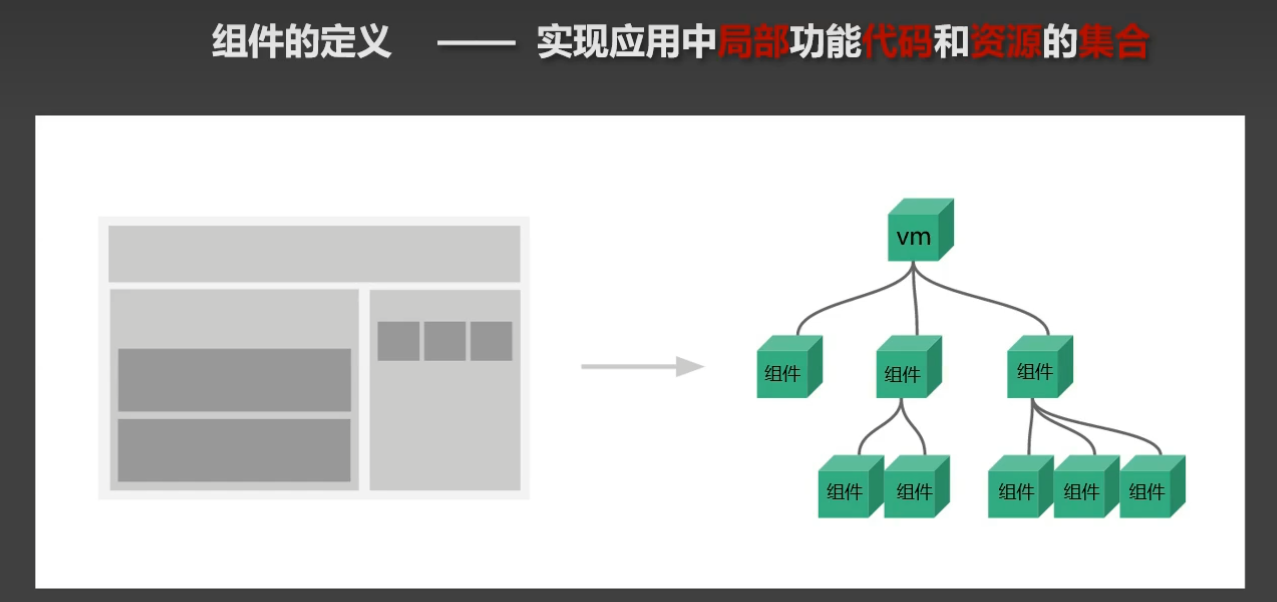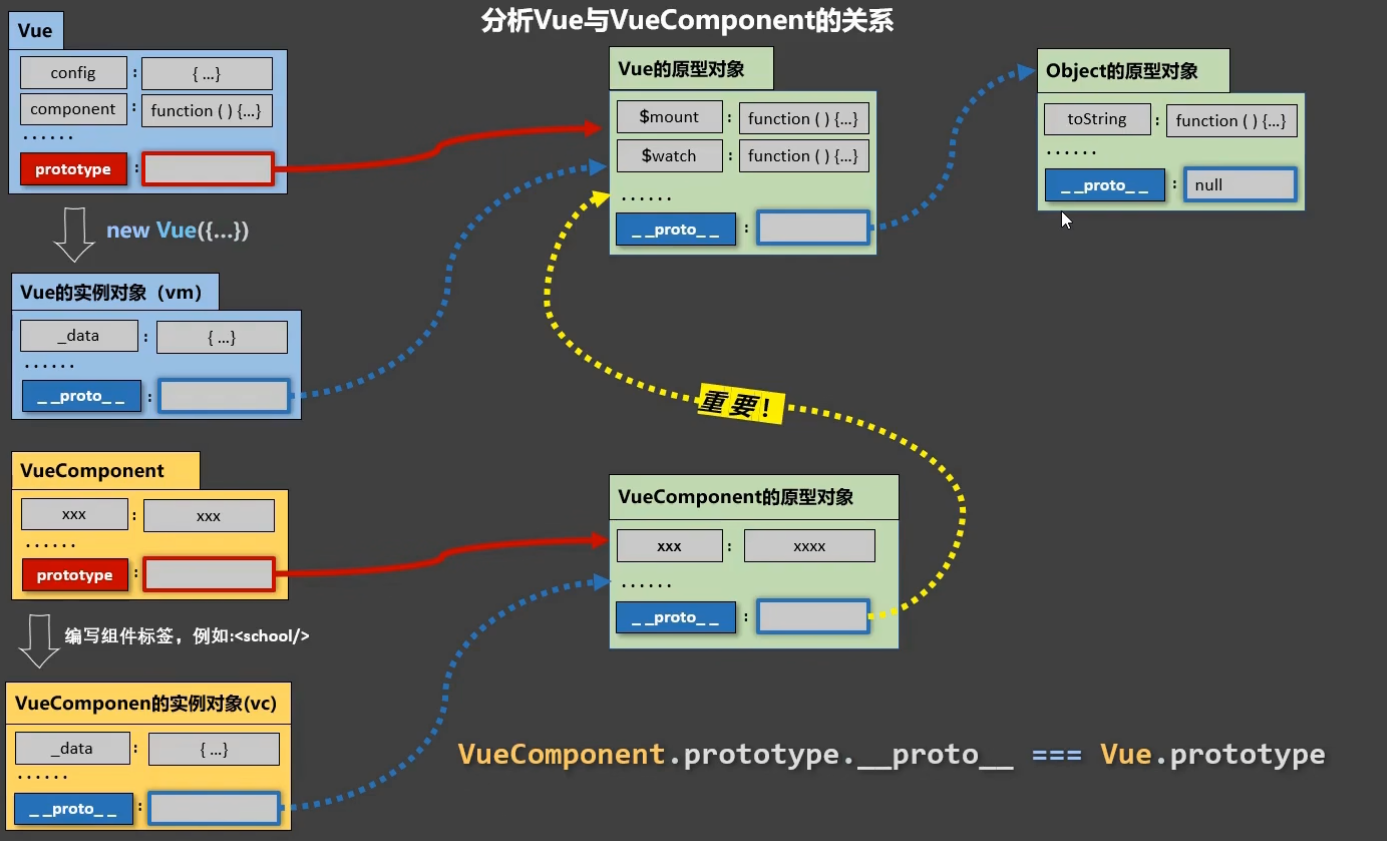基本概念
模块
- 理解: 向外提供特定功能的 js 程序, 一般就是一个 js 文件
- 为什么: js 文件很多很复杂
- 作用: 复用 js, 简化 js 的编写, 提高 js 运行效率
组件
- 理解: 用来实现局部(特定)功能效果的代码集合(html/css/js/image…..)
- 为什么: 一个界面的功能很复杂
- 作用: 复用编码, 简化项目编码, 提高运行效率
模块化
当应用中的 js 都以模块来编写的, 那这个应用就是一个模块化的应用
组件化
当应用中的功能都是多组件的方式来编写的, 那这个应用就是一个组件化的应用



非单文件组件
-
一个文件中包含有n个组件
-
Vue中使用组件的三大步骤:
- 定义组件(创建组件)
- 注册组件
- 使用组件(写组件标签)
-
如何定义一个组件
- 使用
Vue.extend(options)创建,其中options和new Vue(options)时传入的那个options几乎一样,但也有点区别,区别如下:
el不要写,为什么? ——— 最终所有的组件都要经过一个vm的管理,由vm中的el决定服务哪个容器data必须写成函数,为什么? ———— 避免组件被复用时,数据存在引用关系
- 备注:使用
template可以配置组件结构。
-
如何注册组件
- 局部注册:靠
new Vue的时候传入components选项
- 全局注册:靠
Vue.component('组件名',组件)
-
编写组件标签:<school></school>
1
2
3
4
5
6
7
8
9
10
11
12
13
14
15
16
|
<!-- 准备好一个容器-->
<div id="root">
<hello></hello>
<hr>
<h1>{{msg}}</h1>
<hr>
<!-- 第三步:编写组件标签 -->
<school></school>
<hr>
<!-- 第三步:编写组件标签 -->
<student></student>
</div>
<div id="root2">
<hello></hello>
</div>
|
1
2
3
4
5
6
7
8
9
10
11
12
13
14
15
16
17
18
19
20
21
22
23
24
25
26
27
28
29
30
31
32
33
34
35
36
37
38
39
40
41
42
43
44
45
46
47
48
49
50
51
52
53
54
55
56
57
58
59
60
61
62
63
64
65
66
67
68
69
70
71
72
|
//第一步:创建school组件
const school = Vue.extend({
template:`
<div class="demo">
<h2>学校名称:{{schoolName}}</h2>
<h2>学校地址:{{address}}</h2>
<button @click="showName">点我提示学校名</button>
</div>
`,
// el:'#root', //组件定义时,一定不要写el配置项,因为最终所有的组件都要被一个vm管理,由vm决定服务于哪个容器。
data(){
return {
schoolName:'尚硅谷',
address:'北京昌平'
}
},
methods: {
showName(){
alert(this.schoolName)
}
},
})
//第一步:创建student组件
const student = Vue.extend({
template:`
<div>
<h2>学生姓名:{{studentName}}</h2>
<h2>学生年龄:{{age}}</h2>
</div>
`,
data(){
return {
studentName:'张三',
age:18
}
}
})
//第一步:创建hello组件
const hello = Vue.extend({
template:`
<div>
<h2>你好啊!{{name}}</h2>
</div>
`,
data(){
return {
name:'Tom'
}
}
})
//第二步:全局注册组件
Vue.component('hello',hello)
//创建vm
new Vue({
el:'#root',
data:{
msg:'你好啊!'
},
//第二步:注册组件(局部注册)
components:{
school,
student
}
})
new Vue({
el:'#root2',
})
|

几个注意点
- 关于组件名
- 一个单词组成:
- 第一种写法(首字母小写):
school
- 第二种写法(首字母大写):
School(推荐)
- 多个单词组成:
- 第一种写法(kebab-case命名):
my-school
- 第二种写法(CamelCase命名):
MySchool (需要Vue脚手架支持)(推荐)
- 备注:
- 组件名尽可能回避
HTML中已有的元素名称,例如:h2、H2都不行
- 可以使用
name配置项指定组件在开发者工具中呈现的名字
- 关于组件标签:
- 第一种写法:
<school></school>
- 第二种写法:
<school/>
- 备注:不用使用脚手架时,
<school/>会导致后续组件不能渲染。
- 一个简写方式:
const school = Vue.extend(options)可简写为:const school = options
1
2
3
4
|
<div id="root">
<h1>{{msg}}</h1>
<school></school>
</div>
|
1
2
3
4
5
6
7
8
9
10
11
12
13
14
15
16
17
18
19
20
21
22
23
24
25
26
|
//定义组件
const s = Vue.extend({
name:'atguigu',
template:`
<div>
<h2>学校名称:{{name}}</h2>
<h2>学校地址:{{address}}</h2>
</div>
`,
data(){
return {
name:'wyatt',
address:'xian'
}
}
})
new Vue({
el:'#root',
data:{
msg:'欢迎学习Vue!'
},
components:{
school:s
}
})
|

组件嵌套
1
2
3
4
|
<!-- 准备好一个容器-->
<div id="root">
</div>
|
1
2
3
4
5
6
7
8
9
10
11
12
13
14
15
16
17
18
19
20
21
22
23
24
25
26
27
28
29
30
31
32
33
34
35
36
37
38
39
40
41
42
43
44
45
46
47
48
49
50
51
52
53
54
55
56
57
58
59
60
61
62
63
64
65
66
67
68
69
70
|
//定义student组件
const student = Vue.extend({
name:'student',
template:`
<div>
<h2>学生姓名:{{name}}</h2>
<h2>学生年龄:{{age}}</h2>
</div>
`,
data(){
return {
name:'wyatt',
age:18
}
}
})
//定义school组件
const school = Vue.extend({
name:'school',
template:`
<div>
<h2>学校名称:{{name}}</h2>
<h2>学校地址:{{address}}</h2>
<student></student>
</div>
`,
data(){
return {
name:'xaut',
address:'xian'
}
},
//注册组件(局部)
components:{
student
}
})
//定义hello组件
const hello = Vue.extend({
template:`<h1>{{msg}}</h1>`,
data(){
return {
msg:'欢迎来到xaut学习!'
}
}
})
//定义app组件
const app = Vue.extend({
template:`
<div>
<hello></hello>
<school></school>
</div>
`,
components:{
school,
hello
}
})
//创建vm
new Vue({
template:'<app></app>',
el:'#root',
//注册组件(局部)
components:{app}
})
|

VueComponent
-
组件本质是一个名为VueComponent的构造函数,且不是程序员定义的,是Vue.extend生成的。
-
我们只需要写<school/>或<school></school>,Vue解析时会帮我们创建school组件的实例对象,即Vue帮我们执行的:new VueComponent(options)
-
特别注意:每次调用Vue.extend,返回的都是一个全新的VueComponent
-
关于this指向:
- 组件配置中:
data函数、methods中的函数、watch中的函数、computed中的函数 它们的this均是VueComponent实例对象
new Vue(options)配置中:data函数、methods中的函数、watch中的函数、computed中的函数它们的this均是Vue实例对象
-
VueComponent的实例对象,以后简称vc(也可称之为:组件实例对象)
-
Vue的实例对象,以后简称vm
1
2
3
4
5
|
<!-- 准备好一个容器-->
<div id="root">
<school></school>
<hello></hello>
</div>
|
1
2
3
4
5
6
7
8
9
10
11
12
13
14
15
16
17
18
19
20
21
22
23
24
25
26
27
28
29
30
31
32
33
34
35
36
37
38
39
40
41
42
43
44
45
46
47
48
49
50
51
52
|
//定义school组件
const school = Vue.extend({
name:'school',
template:`
<div>
<h2>学校名称:{{name}}</h2>
<h2>学校地址:{{address}}</h2>
<button @click="showName">点我提示学校名</button>
</div>
`,
data(){
return {
name:'xaut',
address:'xian'
}
},
methods: {
showName(){
console.log('showName',this)
}
},
})
const test = Vue.extend({
template:`<span>atguigu</span>`
})
//定义hello组件
const hello = Vue.extend({
template:`
<div>
<h2>{{msg}}</h2>
<test></test>
</div>
`,
data(){
return {
msg:'你好啊!'
}
},
components:{test}
})
// console.log('@',school)
// console.log('#',hello)
//创建vm
const vm = new Vue({
el:'#root',
components:{school,hello}
})
|

Vue与VueComponent关系
- 一个重要的内置关系:
VueComponent.prototype.__proto__ === Vue.prototype
- 为什么要有这个关系:让组件实例对象(vc)可以访问到 Vue原型上的属性、方法

1
2
3
|
<div id="root">
<school></school>
</div>
|
1
2
3
4
5
6
7
8
9
10
11
12
13
14
15
16
17
18
19
20
21
22
23
24
25
26
27
28
29
30
31
32
33
|
Vue.prototype.x = 99
//定义school组件
const school = Vue.extend({
name:'school',
template:`
<div>
<h2>学校名称:{{name}}</h2>
<h2>学校地址:{{address}}</h2>
<button @click="showX">点我输出x</button>
</div>
`,
data(){
return {
name:'xaut',
address:'xian'
}
},
methods: {
showX(){
console.log(this.x)
}
},
})
//创建一个vm
const vm = new Vue({
el:'#root',
data:{
msg:'你好'
},
components:{school}
})
|

单文件组件
index.html
1
2
3
4
5
6
7
8
9
10
11
12
13
|
<!DOCTYPE html>
<html>
<head>
<meta charset="UTF-8" />
<title>练习一下单文件组件的语法</title>
</head>
<body>
<!-- 准备一个容器 -->
<div id="root"></div>
<!-- <script type="text/javascript" src="../js/vue.js"></script> -->
<!-- <script type="text/javascript" src="./main.js"></script> -->
</body>
</html>
|
main.js
1
2
3
4
5
6
7
|
import App from './App.vue'
new Vue({
el:'#root',
template:`<App></App>`,
components:{App},
})
|
App.vue
1
2
3
4
5
6
7
8
9
10
11
12
13
14
15
16
17
18
19
20
|
<template>
<div>
<School></School>
<Student></Student>
</div>
</template>
<script>
//引入组件
import School from './School.vue'
import Student from './Student.vue'
export default {
name:'App',
components:{
School,
Student
}
}
</script>
|
School.vue
1
2
3
4
5
6
7
8
9
10
11
12
13
14
15
16
17
18
19
20
21
22
23
24
25
26
27
28
29
30
|
<template>
<div class="demo">
<h2>学校名称:{{name}}</h2>
<h2>学校地址:{{address}}</h2>
<button @click="showName">点我提示学校名</button>
</div>
</template>
<script>
export default {
name:'School',
data(){
return {
name:'xaut',
address:'xian'
}
},
methods: {
showName(){
alert(this.name)
}
},
}
</script>
<style>
.demo{
background-color: orange;
}
</style>
|
Student.vue
1
2
3
4
5
6
7
8
9
10
11
12
13
14
15
16
17
18
|
<template>
<div>
<h2>学生姓名:{{name}}</h2>
<h2>学生年龄:{{age}}</h2>
</div>
</template>
<script>
export default {
name:'Student',
data(){
return {
name:'张三',
age:18
}
}
}
</script>
|








